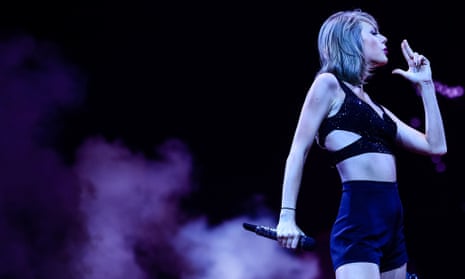I was going to start this article with Verdi. Until a week or so ago, my most recent experience of music-induced shivers down my spine, goosebumps, feelings of exhilaration – we’ll call them “the chills” – came during a performance of the Italian composer’s Requiem. It was the Dies Irae, one of the most intense and terrifying pieces of music in the classical canon (and fair enough, it’s meant to represent the Day of Judgment). The crashing of the timpani, the wailing of the choir. This I thought, would be a fitting introduction for an essay on a most mysterious musical phenomenon.
Unfortunately, while I was driving through town with a friend the other day, Taylor Swift came on the radio. A minute or two in – the song was Bad Blood – I felt the skin over my arms tighten, then looked down to see all my hairs standing on end. I might have wanted to sound highbrow, but it seems my body had other ideas.
Why did that happen? It’s not that I don’t like Swift, I just don’t have particularly strong feelings about her music. But before we get to that – what even was happening? According to neuroscientist Jessica Grahn I experienced a form of autonomic nervous system arousal, the evolutionarily ancient preparation for fight or flight. As well as piloerection (those hairs standing on end) if I’d been hooked up to medical monitors, they would have detected increased heart rate, perspiration and faster, deeper breathing.
Then there’s the emotional component. Arousal by itself, Grahn tells me, is emotionally neutral – excitement and fear result in much the same set of physiological changes. Only by asking a subject if they’re elated or afraid can we tell the difference. Musical chills are usually experienced as pleasurable, even ecstatic. If it’s the mind that provides the emotional colouring in, what’s going on in there?
Researchers have shown that activity in the nucleus accumbens, deep inside the brain, increases during chills. “What’s interesting about this,” says Grahn, “is that it’s what we call a reward structure. So it responds to all sorts of biological rewards like food, or sex or drugs. And the chemical that’s released during musical chills, dopamine, is one that is also acted on by things like cocaine or amphetamine or other intensely pleasurable experiences.”
Anyone who’s felt musical chills will instinctively recognise this. Not everybody does – one experiment found that 47% of non-musicians had never experienced them, which, in my opinion, is a huge misfortune for the people concerned. They are among the most instantaneously exciting sensations you can experience. They involve the body and the mind together, and often seem deeply significant: giving you access to something bigger than yourself, something ineffable.
Often, but not always. Suspecting that some cleverly designed device was tugging at my nerve endings during the Swift song, I pinpointed the moment I felt the chill (at about 1 minute 34 seconds in on the official video) and asked music psychologist John Sloboda what was going on. “This is what is described in musicology as an ‘enharmonic change’ when a melody note stays the same, but is re-interpreted harmonically. The bass note [when she sings “Now we got problems”] forces that re-intepretation. It is also, in the context, a somewhat unexpected event.”
Unexpectedness, it turns out, is key. Back in 1991, Sloboda conducted a study which attempted to match emotional experiences including chills to specific musical structures. “There were 10 cases of enharmonic change in my 1991 data,” he says. “Four of them were associated with tears, and six with shivers down the spine. It was the 4th most frequent elicitor of thrills out of 10 different devices.”
What was the first, then? “Appoggiaturas”. What? “The most well-known classical example is the opening phrase of the violin tune in Albinoni’s Adagio for Strings.” Sloboda says another one can be found at the beginning of the Beatles’ Yesterday – “it’s a note that falls one step down, and the falling down is a kind of resolution”.
The thing that appoggiaturas, enharmonic change and the other structures Sloboda looked at have in common is that they represent dramatic shifts in the music – often in a direction we weren’t expecting. In Grahn’s words, they “startle” us. And that shock taps into a core evolutionary mechanism – to pay attention to a possibly threatening change in the environment. But why should a response linked to fear be so pleasurable? “People go to haunted houses around Halloween, or they go to watch horror movies, and these are filled with startling moments, yet they seek that out. So we do seem to like having these challenges, these unexpected surprises. And the nice thing about music is that it’s a very safe way to experience these – you’re not actually in danger.”
It still feels like there’s a missing piece of the jigsaw. Bad Blood doesn’t mean much to me, so I feel entitled to call myself a victim of very smart songwriting, the use of a trick that’s been shown to key into a reward structure in the brain and give me a buzz. But another song that came on the radio that day was the Pet Shop Boys’ cover of Always On My Mind. That gives me goosebumps because of the amazing synth chords in the riff. But it also reminds me strongly of my childhood. And it’s poignant too, full of regret for mistakes made in a relationship. There are other examples: Like a Prayer works for reasons that aren’t simply musical, so does The La’s There She Goes. This has to be about more than just conjuring with harmony and rhythm.
And the feelings of transcendence that can accompany chills is the tip of the iceberg. Music has an almost unlimited power to move us. Throughout the 1990s a psychologist called Alf Gabrielsson collected accounts of “strong experiences related to music” (SEM). Some of them make for astonishing reading. There are hundreds , but take this example, from an audience member at a performance of Finnish tango music:
I was filled by an enormous warmth and heat. I really swallowed all the notes that were streaming out in the air, not a single note, effect or sequence missed my hungry ears … I was captivated by each of the instruments and what they had to offer me. Nothing else existed! I was dancing, whirling and really gave myself up to the music and rhythms, overjoyed – laughing. Tears came into my eyes – however strange that may seem … Before I was in a very bad state. Depressed. It was during the most critical time ever in my life. I found it hard to get on with people and had to really exert myself to be able to get to grips with things. Afterwards I was bouncy, giggling, lively and filled with deep joy … it was so bewildering that it almost felt as a salvation.
As well as “gooseflesh, piloerection, shivers, thrills and heart race [sic]”, Gabrielsson reported that tears were and extremely common feature of SEM.
For her part, Grahn points out that “emotion regulation is one of the most common reasons people put music on and decide to listen to it”. She explains: “They’re in a bad mood and they want to feel better or they’re in a bad mood and they really want to wallow in it, they’re exercising and they want something motivating and to help them go a bit faster, they’re bored and they want something interesting to help pass the time.” But SEM seem like a different beast altogether. Why does music have this capacity to make us ecstatic?
According to one theory, it helps us form social bonds. “We know that people really enjoy moving together, people pay hundreds of pounds to go to festivals and experience music in a big group. One thing that you can do when you feel the beat is all dance in time. If I don’t have sound, and I’m trying to get a whole group of people to move together, they all have to be able to see each other in order to coordinate – and you can’t do that with very large groups. A drumbeat, on the other hand, could allow a large group to be bound together socially, which may have led to greater altruism and more positive affiliative feelings,” – an evolutionary benefit.
A second theory links the capacity to enjoy music to the development of language. Because language was so useful, Grahn says, “We got very good at linking sounds and movements. Those people who found the idea of making these sounds pleasurable would likely have a survival advantage.” In other words, our capacity to appreciate music, chills and all, evolved for something different: speech. “Music simply taps into [linguistic ability] in the same way that drugs tap into a system that wasn’t designed for drugs – it evolved to support evolutionarily good behaviours like foraging for food and enjoying high-fat meals.”
I like my music delivered through headphones, so I’m not a fan of the group-bonding theory. I also like the idea that a facility for language – the cadences and rhythms of the human voice – goes hand in hand with a love of melody. It certainly seems to be that way for Sloboda. “I find myself, because I’m a singer, hugely moved by the human voice. That amazing thing when everyone is breathing at exactly the same moment and the tuning between the voices is so perfect.”
As a music psychologist he has dissected hundreds of scores, subjected them to endless scrutiny, examined their structure and effects on our behaviour. Is there anything that still gives him the chills?
“The last few minutes of Bach’s Mass in B Minor, the last page or so of the Dona Nobis Pacem. You almost feel you’ve gone to heaven,” he tells me. Amen to that.
What gives you the chills? Musicians and critics share their stories
Little Boots: Our Prayer, the Beach Boys

I’ve been borderline obsessed with the Beach Boys since school, but the piece of music that instantly made the hairs stand on the back of my neck contains not a single word.
Perhaps the fact that it exists beyond language is why the emotion is so pure and the transferral of it so complete. There are not only no words but also no instruments; no driving beat to give you that warm fuzzy feeling. Only abstract, wordless vocals hanging in the air and reverberating through the veins in your body with every cadence. Our Prayer is an abstract acapella piece with little structure or regimentation. It’s a religious experience that for me goes beyond any hymn or spiritual opus, where Brian Wilson is God and his mysterious ways are shown in the melody. Like all truly great pop songs it is complex yet deceptively simple, and so masterfully done it doesn’t need to call on any instrument but the human voice. Gets me every time.
Little Boots’ latest album is Working Girl
Holly Johnson: I Dreamed a Dream, Susan Boyle

I have seen musical spectacles from Ziggy Stardust and the Spiders from Mars to Lou Reed, Diana Damrau’s Queen of the Night, Antony Hegarty and BB King. However, in the 21st century, it’s the TV talent show that has prompted some of the greatest moments. My favourite is Susan Boyle in a frumpy outfit, smiling and clowning for her audition on Britain’s Got Talent. The moment she began to sing I Dreamed A Dream – a song from a dreary stage musical that I had never seen – her voice unexpectedly soared. The audience and kangaroo court of judges erupted in a communal ecstasy at this downtrodden yet undimmed woman, who’d tried and tried again for this moment. This was it – beyond fashion, beyond the pages of broadsheets and the critical hive mind of what’s cool and what’s “art”. The underdog triumphed and we felt it physically, our eyes welling up at the sheer humanity of it all.
Holly Johnson’s album, Europa, is out now
James Rhodes: Piano concerto no.3, Rachmaninov

The last three or four minutes – the struggle between soloist and orchestra, the ultra-romantic melodies, the slowing down then exploding into the final page, the ridiculously lush orchestration and the heroic rush to the finish line where after 45 minutes of sweat, angst, heartache, excitement and escape you are all, listener, soloist, orchestra, conductor, part of the same electric climax (stop smirking at the back).
And the best thing is that there are thousands of other pieces that do the same thing – Bruckner’s 7th symphony, Beethoven’s Emperor concerto, Prokofiev’s 1st piano concerto, Mozart’s Jupiter Symphony, and on and on. Music is the ultimate wonder drug with none of the unpleasant side-effects and all of the brain chemistry magic.
James Rhodes is a classical pianist
Sonya Aurora Madan: Mr Bojangles, Sammy Davis Jr

The most poignant song I can think of, right now anyway, is Sammy Davis Jr’s version of Mr Bojangles, which I heard last year when our guitarist, Glenn Johansson, played it for me. The song is about a down-and-out old street dancer who is thrown in jail and is reminiscing about his life and a much-loved dog he once owned. Sammy’s version resonates with all the poignancy of a real connection to the lyrics. During his upbringing, dancing with his uncle and dad, he himself might have seen many a down-on-his-luck performer, and thanked God for his own good luck.
His constant experience of racism in 20th century America, and the slight get-out clause of being a performer, which offered some respite to a black man, must have left a bittersweet taste. I feel transported, elated and saddened all at the same time when I hear it.
Sonya Aurora Madan is lead singer of Echobelly
Fuse ODG: Keep Ya Head Up, Tupac Shakur

I guess goosebumps are probably the brain’s ingenious way of letting you know you are listening to something important and out of the ordinary. For every song that has ever had that effect on me, I can remember the exact moment and general time in my life when I originally heard it.
Songs like these teach you something and resonate throughout time. Tupac Shakur’s line in his song Keep Ya Head Up – “They got money for wars, but can’t feed the poor”: that’s relevant to any century in human history.
Fuse ODG won best African act in the 2014 Mobo awards
Caroline Sullivan: Gonna Fly Now (Theme from Rocky)

Rocky’s moment of triumph, as he bounds up the steps of the museum as dawn breaks over Philadelphia, is all the more moving because this song is pushing him along. I still well up when I hear it – not just because it captures the moment when Rocky breaks free from the dashed hopes of his past, but also because it reminds me of growing up in 1970s America. It embodies the good things of that time: the can-do spirit and the neighbourliness.
That said, I didn’t really connect with it until after I moved to London and, feeling homesick one day in the early 90s, watched the film. When it reached the Gonna Fly Now scene – heralded by trumpets and disco synths (it’s very much of its time, in a musical sense) – and the camera panned across Philly’s industrial landscape, I snivelled like an idiot. It still has the same effect today.
Caroline Sullivan is a rock and pop critic
John Harris: There Is A Light That Never Goes Out, The Smiths

It causes goosebumps as soon as it starts, but also tends to make me well up. The reasons – I think, anyway – are twofold. It instantly takes me back to being 16, the mixture of excitement and melancholia that often comes with that kind of age, and the experience of somehow seeing all of that crystallised when I watched The Smiths play at Salford University in 1986 – probably the most passionate, heaving collective celebration of music I’ve ever experienced.
But a lot of my reaction is simply down to the song and what it evokes: a kind of epic sadness that goes very, very deep. I have to be careful how often I play it: once or twice a year, at the most. Which, strangely, is a sign of the genius at work.
John Harris is a columnist and former editor of Select magazine
Additional interviews by Caroline Sullivan

